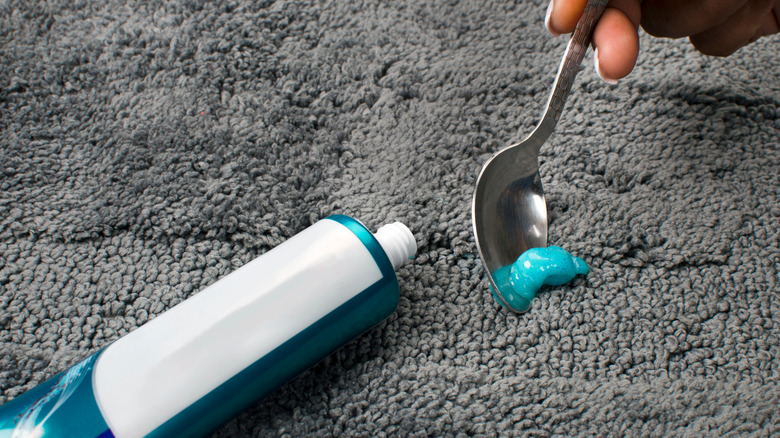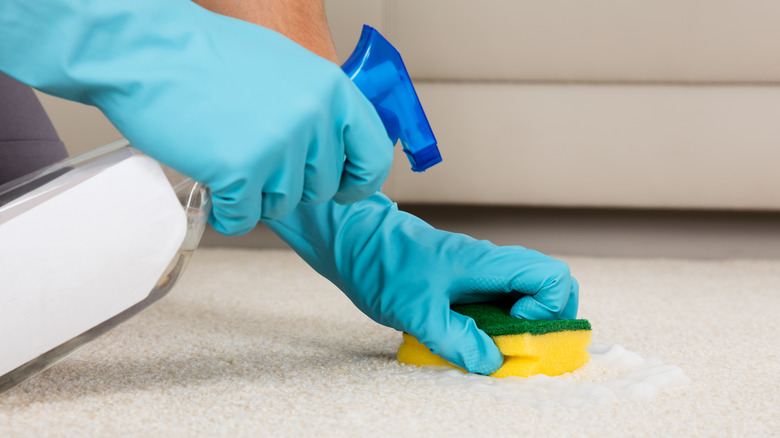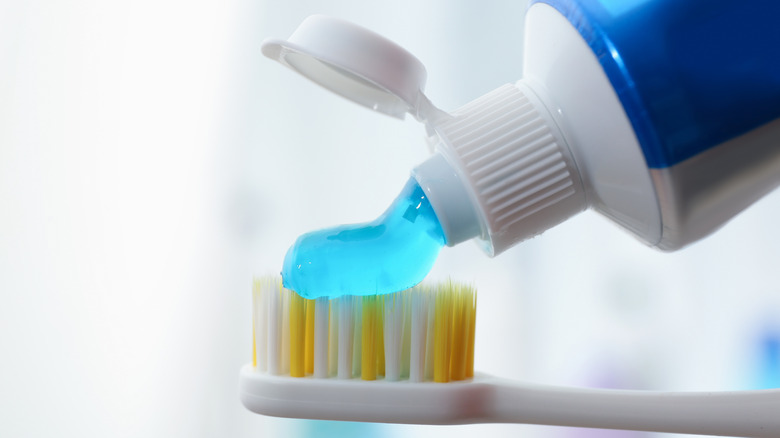How To Effectively Remove Toothpaste Stains From Carpet
Toothpaste stains on carpets are not as uncommon as you might think. Whether you're a diehard multitasker, your kids brush in front of the TV, or your bathroom is carpeted, finding a clump of toothpaste by your feet is part of life in a busy household. The good news is toothpaste is water soluble, so preventing it from ruining your flooring is fairly simple. In fact, you don't even need commercial cleaners to get rid of toothpaste stains. All it takes to effectively remove toothpaste marks from carpet are common pantry staples — like liquid dish soap — and a gentle touch.
But let's back up a bit. Ultimately, the best way to prevent toothpaste from staining your carpet to begin with is to remove it as soon as possible. If you can scoop up the blob of fallen toothpaste with a spoon or dab the spots while they are fresh, the likelihood of teeth cleaner staining your carpet is low. However, dried or ground-in toothpaste that has been left to sit or inadvertently stepped on and worked into carpet fibers requires more time and energy to remove. Fortunately, even stubborn toothpaste stains can be removed without purchasing professional cleaning agents.
Removing toothpaste stains with everyday items
There is a plethora of DYI cleaners that successfully remove toothpaste stains from carpets, many of which are sitting in your kitchen right now. One of the most common is liquid dish soap. After removing large globs or splotches of toothpaste from your carpet, mix 2 teaspoons of dish soap with 2 cups of cool water. Next, dip a clean rag, sponge, or cleaning brush with soft bristles into the solution and gently apply it to the stain, working your way from the outside in. Resist the temptation to aggressively scrub the soiled area — doing so may damage the carpet fibers. Also, if you go a bit overboard applying the solution, simply blot any excess moisture with a dry cloth. Repeat the process until the stain lifts, then rinse the area with a rag dipped in clean water, making sure not to leave any soapy residue on the carpet. Finally, let the damp carpet air dry before vacuuming it to fluff the fibers.
If you don't have dish soap available, substitute it with white vinegar. Just pour 4 tablespoons of vinegar into 2 cups of cool water, mix well, and apply the cleaner to the toothpaste stain the same way you would with the dish soap. If you are concerned about oversaturating your carpet, consider adding the vinegar solution to a spray bottle and directly spritzing the stain. For larger marks, allow the vinegar solution to sit for about 1 minute before rinsing with clean water.
How to tackle tough toothpaste stains
Standard white toothpaste is easier to remove from carpets than colored gels. However, even neon blue and red gel can be erased with everyday products. To treat carpet stained with gel-based tooth cleaners, pour a small amount of plain club soda on the affected area. Allow it to sit for about 2 minutes before gently blotting the area with a clean rag. You should see the stain disappear as you lightly dab. If not, reapply the club soda and gently rub the spot until it's gone.
You know what happens when you pour hydrogen peroxide into your toilet. Fortunately, gel-stained carpets can benefit from the same treatment. Simply apply a small amount of 3% hydrogen peroxide directly to the mark. Within a minute you should see the stain vanish. Once that happens, rinse the area by dabbing it with a cloth soaked in clean water. Keep in mind that using too much hydrogen peroxide on carpet for too long may cause discoloration; consequently, it's best to spot-test a hidden portion of your carpet first.
If all else fails, try baking soda. After removing excess toothpaste gel from your carpet, sprinkle baking soda over the entire stain. Next, use a water-filled spray bottle to dampen the baking soda-covered stain. Let the paste sit for at least 2 hours before softly scrubbing the spot. You will see the stain lift during the process. Once the area is dry, vacuum up any residual baking soda.


